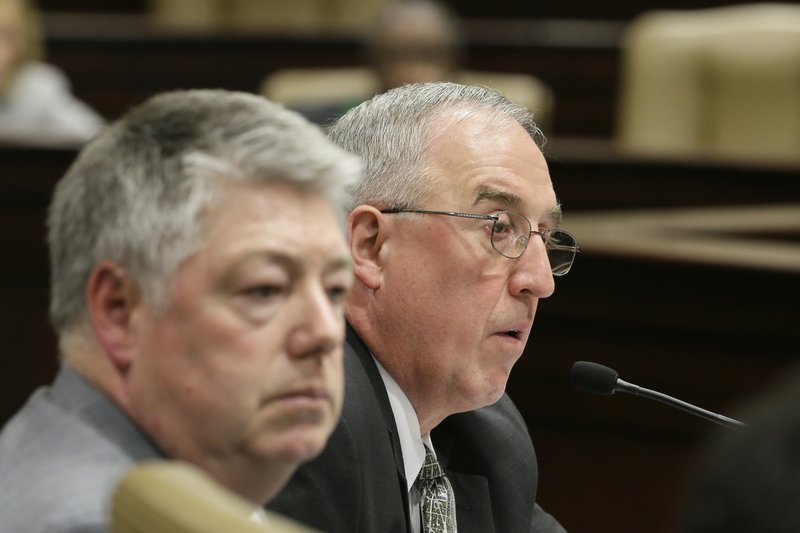The Arkansas Legislature's Joint Agriculture, Forest and Economic Development Committee heard over five hours of testimony Monday afternoon from groups involved in the Big River Steel project.
State officials want Arkansas lawmakers to authorize $125 million in bonds to help build the steel mill. The mill, to be built in Osceola in northeast Arkansas, is projected to cost $1.1 billion. Amendment 82 in the Arkansas Constitution, titled Obligation Bonds for Economic Development, allows the state to issue bonds "to finance infrastructure or other needs to attract large economic development projects."
The steel mill is the first project in which officials have sought aid under the amendment. Big River Steel says the project will employ 525 people with an average salary and bonus pay of more than $75,000 per year.
The committee first heard from IHS Global and Regional Econometric Modeling Inc. (REMI) representatives. Both companies submitted findings last week on the proposed steel mill.
IHS Global Insight said in a report released Thursday that the state overestimated the long-term benefit of the project.
The Economic Development Commission estimated economic benefits ranging from $49.8 million to $54.2 million in two 20-year analyses, but IHS said in its report that the estimates "may be unrealistically optimistic."
IHS continued in the report that the state overestimated the benefits because "it did not fully consider the uncertainties that surround some of the key assumptions."
A second study, released Friday by REMI said the project's value would nearly be offset by state costs.
"The large investments and operations do generate jobs, but the size of the incentives erodes much of the tax revenue presented to the state in the form of increased economic activity, payroll, taxable income and business sales," REMI said in its report.
Both parties echoed their report findings before the committee Monday.
IHS Director Phil Hopkins outlined key uncertainties the company had with the project, the biggest was a tax credit that could cost the state over $200 million.
Hopkins said if the tax credit stayed as is, the project would not be a "slam dunk," but a "close call."
REMI economists said under "sunny assumptions" the state stands to gain from the project, but also said that even if the project did not meet its potential, it would have a positive effect for the state.
REMI economist Scott Nystrom echoed the firm's report in saying the firm believed the project would create 3,600 jobs during construction and 1,300 jobs in the following years.
It was disclosed during the meeting that Nucor Steel, an opponent of the project, was a client of IHS.
IHS manager John Anton said the company had no conversations or contact with Nucor during its review of the Big River Steel project.
Anton said Nucor made no suggestions and if they had "I wouldn't have listened."
Anton later told the committee that his client was the state of Arkansas, not just Nucor Steel.
Nucor Steel has two plants in close proximity to the proposed Big River Steel mill planned in Osceola, and has been an outspoken opponent of the project.
The committee also heard testimony from state economic officials, including Arkansas Economic Development Commission director Grant Tennille. Tennille said he disagreed with the two consulting firms findings on the tax credit, stating the only money the state is responsible for is the $125 million bond. The rest of the credits are based on performance and are only collectable if the steel mill is viable.
Officials from the Big River Steel project and Nucor Steel also gave testimony before the committee.
John Correnti, the leader of the Big River Steel project said he was confident about the potential success of the mill.
Correnti, who helped start both Nucor plants, said at the last plant he opened, located in Mississippi, more than 10,000 applied for 450 jobs. While he said he could not guarantee the same would happen in Osceola, he expected the same outcome.
Lawmakers asked Correnti if he would be able to coincide with existing Nucor plants. Correnti said he had no problem with Nucor and could live with them, "whether they can live with me or not."
Correnti questioned Nucor's concerns about the Big River Steel, citing Nucor produced over 20 million tons of steel in 2012, while Big River Steel projects to produce 1.7 million tons.
Correnti also said Big River Steel would not be in direct competition with Nucor.
Nucor Steel Arkansas president Sam Commella disagreed with Correnti's stance.
Commella said Nucor was not afraid of competition, but if Big River Steel was built, it could force the company to move jobs out of its two Arkansas plants.
Commella said Nucor has received around $160 million in tax credits from the state of Arkansas, and that Big River Steel should not receive $125 million in "start up money."
Read Tuesday's Arkansas Democrat-Gazette for full details.

